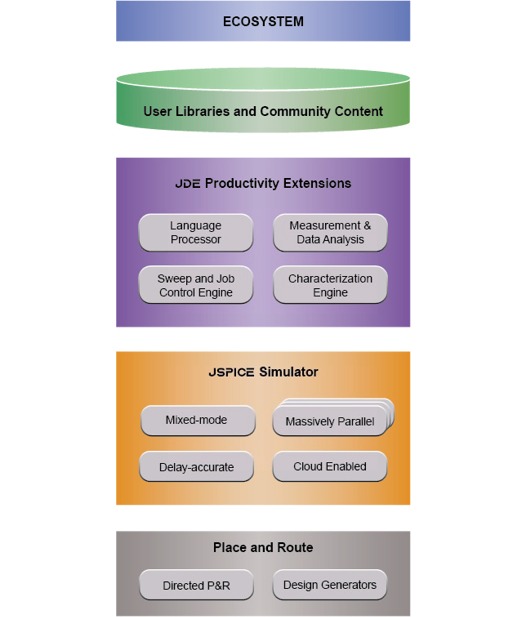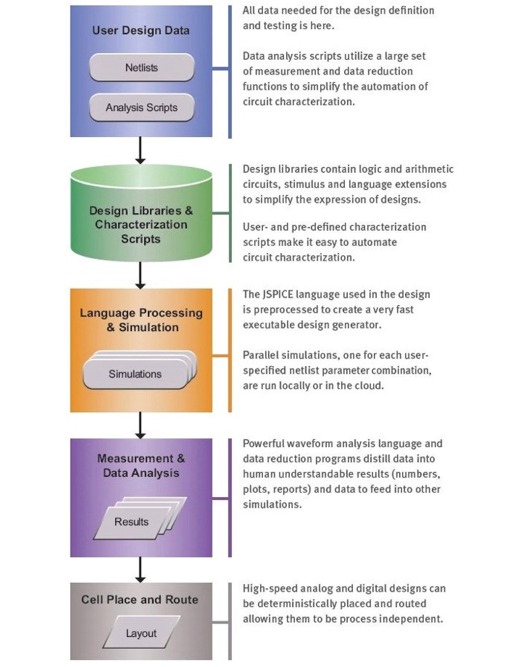 |
 |
 |
 |
 |
JDETM
is a powerful open design environment and ecosystem that greatly accelerates the creation of complex analog and digital circuits by enabling designers to explore, automate and innovate without restrictions or compromise.
|
 |
 |
 |
JDE Product Brief
|
 |
JDE White Paper
|
 |
 |
 |
 |
*
Quickly define complex circuits
*
Quickly define insightful measurements
*
Quickly perform complete characterizations
*
Run an unlimited number of simulations in parallel
*
Automatically reduce results to key metrics
*
Rapidly build intuition with quick feedback
*
Utilize large library of circuits and generators
*
Create circuits that are correct by construction
|
 |
 |
 |
 |
*
Simulate with all foundry models
*
Simulate with Verilog-A, C or behavioral models
*
Run delay-accurate mixed-mode simulations
*
Perform logic/arithmetic synthesis
*
Perform Monte Carlo and timing analysis
*
Automatically place and route cells
*
Configured for AWSTM, AzureTM, Google CloudTM
|
 |
 |
 |
 |
*
Collaborate with a community of other JDE users
*
Share content, services and development effort
*
Use open-source content or premium content
*
Empower university students to pursue analog design
*
Accelerate design at start-ups and research groups
*
Utilize open-source and AI as technology enablers
*
Build a community of explorers and innovators
*
Make CAD budgets go further
|
 |
 |
 |
 |
*
JSPICE Preprocessor
>
Language processor
>
Statistical timing analyzer
*
JSPICE Simulator
>
Core simulator
>
Netlist processing programs
*
JANA Sweep and Measurement Engines
>
Simulation sweep engine
>
Waveform measurement engine
>
Data analysis engine
*
JCHAR Circuit Characterization Engine
>
File processor compiler
>
Characterization flows
>
Logic gate characterization engine
*
JCLOUD Resource Connector
>
Large-scale job controller
>
Cloud process server
>
Cloud file server
>
General license server
*
JPROBE Schematic Prober and Analyzer
>
Programmable definitions and flow control
>
User- and pre-defined measurements
*
JLIBS Design Libraries
>
Stimulus library
>
Logic and arithmetic library
>
Microprocessor library
>
Synthesis function library
>
Device model organization library
*
JDOCS Documentation and Application Notes
>
Software installation guide
>
User guide
>
Cloud enablement guide
>
Application notes
|
 |
 |
 |
 |
|
 |
 |
 |
 |
 |
Ecosystem |
 |
A vibrant community of collaborators, from universities and
businesses to individual designers, all providing content and
services to make JDE the development environment of the future.
|
 |
User Libraries and Community Content |
 |
A growing collection of complete designs, modules, generators,
test suites, characterization flows, standard cells, all the things
needed to accelerate circuit design and maximize productivity.
|
 |
JDE Productivity Extensions |
 |
Expressive netlist language with directed logic synthesis makes
it easy to abstract designs into powerful design generators.
|
Sweep engine varies parameters and job control engine
manages thousands to millions of simulations seamlessly.
|
Measurement and data analysis environment is packed with
functions and reduces massive data into insightful information
that builds intuition and encourages exploration.
|
Characterization engine allows user-specified characterization
flows to be fully encapsulated and automated.
|
 |
JSPICE Simulator |
 |
Industry SPICE-compatible mixed-mode simulator with
delay-accurate behavioral modeling, Verilog-A support,
transient noise analysis, static timing analysis, multi-threaded
execution, and full foundry SPICE model support.
|
Measurements can control stimulus and path simulations can
simulate large designs quickly with SPICE-level accuracy.
|
Configured for AWS, Azure and Google Cloud for
massively parallel simulations and 100X or more increases in
real-world throughput.
|
 |
Place and Route |
 |
Placement data in the netlist source can direct P&R for
high-speed designs.
|
Makes it easy to create process-independent designs.
|
 |
 |
 |
 |
JDE makes it easy for users to rapidly design
circuits. The key to rapid design is being able to
quickly build intuition by iterating through changes
and receiving quick and complete characterization
feedback. JDE makes it easy to quickly define
complex circuits, add structural options for testing,
define insightful measurements, run complete
characterizations over PVT and operating conditions
in minutes, and automatically reduce the results to
easily understood metrics. This enhanced understanding
allows users to make definitive circuit changes that
avoid optimization of a flawed design. Closing this
iteration loop in minutes rather than hours or days is
instrumental to rapid design.
|
 |
 |
 |
 |
The JSPICE language is a dramatically extended
version of generic SPICE circuit descriptions, which
also includes optimized support for industry SPICE
simulator syntax. While the language can be used
with schematic capture, it essentially makes
schematic capture obsolete for efficient design.
The language adds both extended syntax and the
C programming language to make statements
surprisingly expressive and clear. It is compiled and
supports precompiled objects for very fast access to
large design libraries and data sets. It can generate
not only generic SPICE output, but also Verilog,
SDC constraints, LIB files, drive place and route
flows for high-speed designs, and much more.
|
 |
 |
 |
 |
The JSPICE cloud server allows users to run single
simulations or thousands, even millions, in parallel
with no additional effort.
The server supports
an interface similar to LSF to facilitate moving existing workloads.
The server handles the task
of scheduling simulation processes and transferring
files and data to both local and cloud compute
resources seamlessly. Local compute resources can
be used efficiently for small jobs, while the cloud
resources will be automatically allocated as needed
within the user-defined limits.
|
 |
 |
 |
 |
JDE makes it easy to express complicated circuits, run
a large set of simulations in parallel, perform complex
waveform analysis and reduce the results to a form
easily understood by the user, all leading to very rapid
turnaround of circuit characterizations. A typical design
flow is as follows:
|
 |
 |
 |
 |
 |
 |
 |
 |
JDE enables users to achieve faster results by
incorporating modern design and software
technologies that greatly improve design productivity
and encourage exploration and innovation.
|
 |
Massively Parallel Simulation |
 |
JDE users can run massively parallel simulations,
either locally or in the cloud, or both with unlimited
JSPICE licenses. Users can sweep multiple parameters
from min to max over all PVT corners, and JDE will
create and manage those thousands of simulations and
distill the results into the optimal design parameters.
|
 |
Modern Text-Based Scripts and Programming |
 |
GUIs and schematics are a slow way to design. They
resist automation. JDE incorporates text, processing code
and scripts that move analog design into the realm of
modern software. This will help attract young software-
savvy talent to the field of analog design and result in
further progress in design automation.
|
 |
Cell-Based Design and Layout |
 |
JDE moves layout from mostly hand-drawn to
cell-based without losing the layout control needed
for critical circuits. The JDE design database contains
placement information that allows routing to be done
automatically. The bulk of the layout porting effort is
thereby reduced to building and characterizing a set
of cells.
|
 |
 |
 |
 |
Open collaboration between users, content creators and
service providers can spur innovation and dramatically
reduce design time. While open collaboration is common
in the world of commercial software, it is not common in
the semiconductor industry. JDE hopes to change that
by building a strong ecosystem that can populate
libraries with rich content including useful modules or
complete designs, data analysis utilities, easily modified
characterization scripts, and test suites for common
protocols or applications. In addition to support and
services from True Circuits, JDE users will also be able to
draw on ecosystem service providers with the staffing and
expertise to accelerate JDE adoption and ease-of-use.
The future of semiconductors lies with universities that
attract and train young engineering talent and JDE is
well positioned to be their design environment of choice.
|
 |
 |
 |
 |
Individuals, students or employees of companies can submit a membership
application by completing the form at
JDE Membership Application.
The application process will ask users to agree to the terms of
the JDE membership program, including providing periodic feedback and
participating in user forums. Users will be accepted by True Circuits, at
its sole discretion, into the program for a selected period of time.
Accepted users will be provided the JDE software suite, user guidelines,
related documentation and a True Circuits point of contact for user support
and feedback.
For those attending the Design Automation Conference in San Francisco, June
23-25, 2025, we will be giving JDE presentations Monday and Tuesday at 11:00
AM, 1:00 PM and 3:00 PM and Wednesday at 11:00 AM and 1:00 PM in our booth #1637.
Please register for a presentation day and time to learn more about this
powerful platform by completing the form at
JDE DAC Presentation.
If you would like a private JDE demo at DAC,
please register at
JDE DAC Demo.
|



